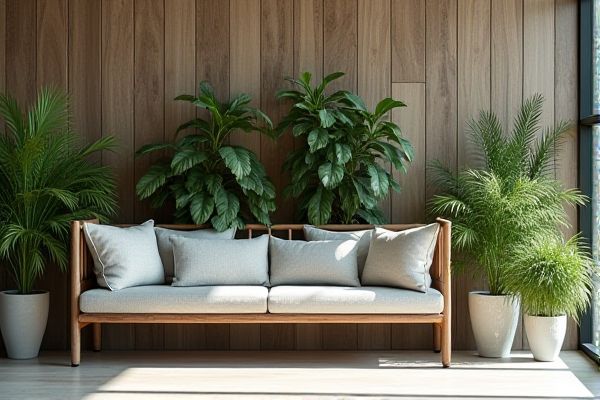
Bench planters combine seating and greenery into a cohesive design, saving space and adding functionality to your outdoor area, while standalone planters offer flexible placement and diverse styles to complement any decor. Discover which option best suits your needs and enhances your garden by reading the full article.
Table of Comparison
| Feature | Bench Planter | Standalone Planter |
|---|---|---|
| Design | Integrated seating with plant container | Separate plant container, no seating |
| Functionality | Dual purpose: seating and planting | Single purpose: plant display |
| Space Utilization | Optimizes space by combining furniture and planter | Requires dedicated space for planter |
| Material Options | Commonly wood, metal, or composite materials | Varies widely: ceramic, plastic, metal, wood |
| Mobility | Usually stationary due to size and weight | Often lightweight and movable |
| Ideal Use | Outdoor patios, gardens, public seating areas | Indoor decoration, balconies, patios |
| Maintenance | Requires cleaning for both seating and planter area | Focuses on plant care and container cleaning |
| Cost Range | Typically higher due to dual functionality | Varies widely, generally lower than bench planters |
Introduction to Bench Planters and Standalone Planters
Bench planters combine seating and greenery, maximizing space and functionality in outdoor or indoor environments, making them ideal for urban areas and patios. Standalone planters offer versatile placement options, allowing you to easily relocate plants to enhance aesthetics or accommodate changing light conditions. Choosing the right option depends on your space, design preferences, and how you want to integrate plants into your environment.
Design and Aesthetics Comparison
Bench planters integrate seating and greenery, offering a multifunctional design that enhances outdoor aesthetics by combining comfort with natural elements. Standalone planters provide greater versatility in placement and style, allowing for a wider range of shapes, sizes, and plant arrangements that can be easily moved or updated. Both options contribute to landscape beauty, but bench planters create a cohesive, inviting environment, while standalone planters emphasize plant display and flexible decor.
Space Efficiency and Placement Options
Bench planters maximize space efficiency by combining seating and gardening in one unit, making them ideal for small patios and urban environments where floor space is limited. Standalone planters offer greater flexibility in placement, allowing users to move and rearrange them according to sunlight and aesthetic preferences. Choosing between the two depends on the balance between functional seating needs and versatile plant display options.
Functional Benefits of Bench Planters
Bench planters combine seating and greenery, maximizing space efficiency in gardens and patios. They provide ergonomic comfort while integrating plants, enhancing both relaxation and aesthetic appeal. This dual functionality supports social interactions and promotes outdoor well-being without requiring additional furniture.
Versatility of Standalone Planters
Standalone planters offer unmatched versatility by allowing gardeners to easily reposition plants based on seasonal sunlight and space requirements, unlike bench planters which are fixed. Their portability accommodates diverse environments, from patios to balconies, making them ideal for urban gardening and small spaces. The wide range of sizes, shapes, and materials available for standalone planters enhances design flexibility and supports various plant types and growth habits.
Material Choices and Durability
Bench planters typically feature sturdy materials like treated wood, metal, or composite blends designed to withstand outdoor conditions while doubling as seating, enhancing durability under weight and weather stress. Standalone planters offer a wider variety of material choices, including ceramic, plastic, concrete, and metal, allowing you to select based on specific aesthetic preferences and durability requirements for your environment. Your choice between bench and standalone planters should consider material resilience to factors like UV exposure, moisture, and temperature fluctuations to ensure long-lasting performance.
Installation and Maintenance Requirements
Bench planters typically require more extensive installation, involving secure anchoring to ensure stability and durability, ideal for outdoor public spaces or patios. Standalone planters offer flexible placement with minimal setup, often just requiring proper drainage and occasional repositioning, making them suitable for indoor environments or temporary arrangements. Your choice should consider the desired permanence and ease of maintenance, as bench planters may need periodic structural checks while standalone planters demand regular watering and cleaning.
Suitability for Different Outdoor Settings
Bench planters are ideal for patios, decks, and entryways where seating and greenery coexist, offering a space-saving solution that doubles as functional furniture. Standalone planters suit open garden spaces, walkways, and balconies, allowing flexible placement and easier rearrangement to enhance specific focal points. Both options support a variety of plant types but differ in integration with outdoor layouts and user interaction.
Cost Considerations and Value
Bench planters generally offer greater value by combining seating and planting features in one unit, which can reduce the overall cost of outdoor furnishings. Standalone planters vary widely in price depending on materials and design but may require additional seating solutions, increasing total expenses. When budgeting, bench planters often provide a cost-effective option for maximizing space utility and aesthetic appeal in outdoor environments.
Choosing the Right Planter for Your Needs
When selecting between a bench planter and a standalone planter, consider space efficiency and functionality; bench planters combine seating with greenery, ideal for compact areas or social settings. Standalone planters offer versatility in placement and design, perfect for adding focal points or flexible garden arrangements. Your choice should reflect the balance between practicality, aesthetic appeal, and the intended use of your outdoor or indoor space.
 homyna.com
homyna.com